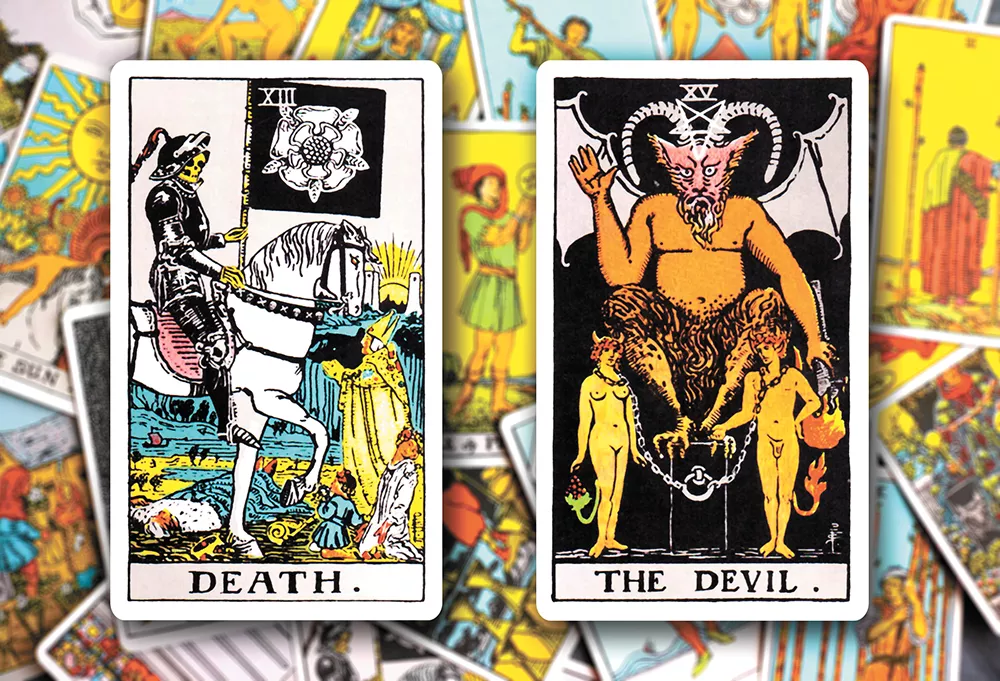Of all the people I interact with as a tarot reader, it's typically the thick-moustached bouncer or weightlifting ex-military guy who trembles hardest at the thought of having "Death" appear in the tarot cards I arrange on my pink velvet cloth.
I suspect these freaked-out dudes have heard campfire stories of tarot readings gone demonically wrong; I suspect most of us have heard a tarot horror tale, or four. At a summer street fair, a tipsy passerby once eyed my "TAROT" sandwich board and moaned, "Oh no! Don't even look in my direction! I don't want to die!" I rolled my eyes as I munched trail mix between clients. Another day at the office!
Some peoples' chests pound with fear of facing down the "Devil" card, a recipient of unfair public relations from movies and pop culture. Despite rumors that pulling the Devil brings danger or opens evil portals, in my 16 years of reading tarot, I've found that the infamous Devil usually appears in a reading to express:
• Career issues
• Imbalanced power dynamics
• Addiction to substances
• Addiction to people with whom you have magnetic physical attraction to but who can't support you emotionally
That's all the Devil is up to.
And yeah, it's a fact that one tarot card in a deck of 78 is literally named Death. That's true. I can see why a person's alarms might chirp at Death. But in my witchly experience, the Death card often relates to someone's transformation. The card depicts the sun rising on a new reality at a vulnerable moment of transition, when the dust of the old way is settling. Neither the Devil nor Death are fuzzy and sweet, but those cards aren't lethal.
Tarot speaks in a language of images (rivers, swords and moons) to show us — with wordless symbols — what we already get on a gut level. Our dreams do this, too. When we dream of a flooded room, we wake up instantly understanding what the dream means. The water evokes a feeling. Film and poetry utilize images and colors in a similar way.
Tarot cards are just analog JPGs that a person unconsciously chooses to show themselves what the heck is going on in their world. Their flipped cards reveal a storyboard that I help explain. Human brains crave story and narrative, so folks easily fill in the blanks and apply a card's themes and archetypes to their life.
Personally, I'm also a bit intuitive: When I touch the deck after a person shuffles, I pick up on certain emotions, family info and experiences.
Tarot doesn't always involve psychic activity or even need to. Tarot is kind of mythic, kind of mystic, kind of ancient RPG like D&D (Dungeons and Dragons). But it's not a game. It's a way of feeling acknowledged by the universe. People cry during readings. Emotions flow. To be crystal (pun intended) clear: Cards can't kill people (unless, perhaps, you used the cards as a murder weapon like a candlestick in Clue). But the fact that tarot is safe doesn't stop people from shuddering at the idea of a reading. Many folks who are scared of tarot are really scared to see — laid out on the pink cloth — truths that their own intuition already knows, because that might require reflection and change.
To the "Don't tell me I'm gonna diiie!" folks, I like to say: "The good news is the cards can't make you die. The bad news is, you're definitely gonna die someday!"
I think we always have free will, and free will is scary. I believe tarot lifts the lid off our kettle and makes us view the stew inside. It's not a subtle teacher, tarot. But it is honest. Like a loyal, close friend who tells you what you need to hear. ♦
Elissa Ball is an author, poet and Wicca-practicing witch originally from Yakima. She reads tarot cards most Thursdays at Chosen Vintage and writes a weekly astrology column called Space Witch.

